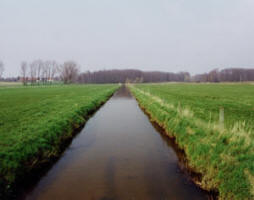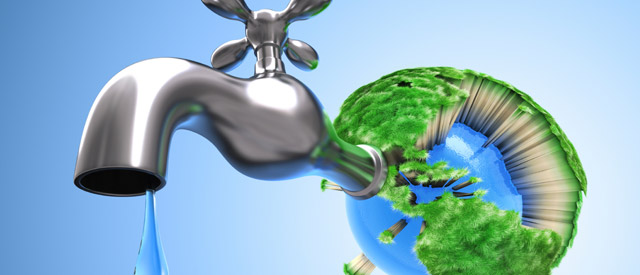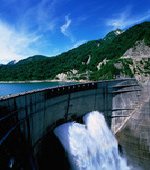 Wise Up To Water Risks
Wise Up To Water Risks
Hydrologists like to call water the “bloodstream of the planet.” But it is more than that. Water is essential to almost all human activities – including those you invest your money in. Today, 20 percent of global GDP is at risk due to water stress.1 A new report released by The World Economic Forum this year identified water supply crises as one of the most likely and potentially highest impact risks that the world of 2013 faces.2
In the CDP Water Disclosure Report of 2012, which surveyed financial institutions with assets of USD 50 trillion, a majority of businesses stated that they face water-related risk presently, and over one-third already suffered impacts with associated costs as high as USD 200 million.3 Two in three surveyed responded that they predict potential setbacks and risks within the next five years. Clearly, water is a big issue for businesses today and it goes far beyond Corporate Social Responsibility obligations.
“Clearly, water is a big issue for businesses today and it goes far beyond Corporate Social Responsibility obligations.”
Challenges in the supply chain
In both the near and medium term, companies fear water shortages and floods as the largest sources of risk by far – with rising costs, both for discharge compliance, and water use, being the next top concerns. Very often, the supply chain accounts for the largest portion of a company’s water use and risk. In 2011, for example, droughts in Pakistan led to a sudden spike in the price of cotton, which directly impacted the bottom line of large textile companies, such as H&M which reported a 30% cut in profits over the first quarter of that year.4
Reputational risks are a primary concern for most companies in their water management. Public campaigns exposing heavy pollution and poor environmental performance of suppliers, have hit big name companies across industries. Green – focused consumers will also add water to their list of concerns when picking between environmentally friendly products and will want companies to be able to attest that their suppliers are held to high standards.
Of course, it is also considerably more difficult to monitor and regulate performance and risk in the supply chain than it is to do for activities that fall under a company’s direct operations. Nearly 3 of 10 Global 500 companies who responded to the CDP Water Disclosure survey said they were unsure if they faced water related risk in the supply chain, while nearly all had completed risk assessments within their direct operations. The survey also showed that many more companies have now begun to require their key suppliers to report on water use and management plans.
This shows that forward looking companies are thinking strategically to set targets to reduce water consumption, not only in their direct operation but also from their strategic suppliers, so that they can better respond to fluctuating costs and shifting availability of water resources. That is because smart CEOs understand that water has a value far beyond its current market price; and pre-emptive action will insulate them from shocks if the cost of water increases as scarcity worsens. This is most essential for water intensive industries – such as the food and beverage processing, chemical, agricultural, energy, mining, construction and textile sectors – but all investors should pay close attention to how resilient their investments are to changes in the water situation where they operate.
“It is important that all companies prioritize the sustainable use of water resources by committing to clear goals and actions that they can take. Explicit targets and commitment from the highest level of leadership within the firms is essential.”
Taking the next step
While water risks have reached the company agenda for most large companies, there is still a long way to go. While the average among European firms is higher, over 40% of the Global 500 companies still do not have concrete water related goals, and do not have board level oversight of their water strategies. It is important that all companies prioritize the sustainable use of water resources by committing to clear goals and actions that they can take. Explicit targets and commitment from the highest level of leadership within the firms is essential to ensure that all within the organization pro-actively work in this area. If your company has not keyed in on the risks it faces with regards to water then it may be in danger of falling behind the curve.
The good news is that there is now more support than ever before to assess the specific challenges and uncertainties and take action. Gaining a basic overview of current performance, the risks faced and options available for improvements is the first step. Knowledge in this field is growing quickly and a small army of smart tools have been developed to aid companies and investors to assess and mitigate water risks, such as the Water Risk Filter5 developed by WWF, and the Aqueduct Water Risk Atlas,6 launched this year by the World Resources Institute together with a number of partners. Both the Aqueduct and the Water Risk Filter help companies plot locations of their facilities, new markets and suppliers and compare those locations’ potential exposure to water related risks. This can help map water management priorities at the local level, and ensure the selection of environmentally suitable locations for business operations.
“Knowledge in this field is growing quickly and a small army of smart tools have been developed to aid companies and investors to assess and mitigate water risks.”
Shared opportunities
Many water challenges go beyond a single actor’s ability to confront, and require a wider leadership across business, government and civil society. There are a number of very positive initiatives that have taken place in recent years to create public-private partnerships like the UN Global Water Compact CEO Water Mandate, which has been endorsed by CEOs from over 80 major companies. Business-to-Business cooperation in the textile industry, which can be seen at the national level in Sweden with the Swedish Textile Water Initiative,7 and internationally with the Sustainable Apparel Coalition, are already bearing fruit to help companies collectively work to improve water stewardship through the sector. The Sustainable Apparel Coalition is also working together to create internationally agreed standards to measure the environmental and social performance of apparel and footwear products, called the “HIGG index.” While still in its infancy, such commonly agreed upon standards are critical to not only effectively regulate performance, but also to incentivize suppliers and companies to invest in clean production. Hopefully, these types of initiatives can produce models that can be replicated and used by more actors within and across other industries.
Ultimately, understanding the risks and opportunities that water presents will help any company avoid unnecessary losses and build a sustainable future. Spending time to make sure your business is water wise is always a smart move.
About the Author
Josh Weinberg is a communication officer at the Stockholm International Water Institute (SIWI), who contributes as a writer and editor on the institute’s publications.
References
1. http://www.veoliawaterna.com/north-america-water/ressources/documents/1/19979,IFPRI-White-Paper.pdf
2. http://www3.weforum.org/docs/WEF_GlobalRisks_Report_2013.pdf
3. https://www.cdproject.net/CDPResults/CDP-Water-Disclosure-Global-Report-2012.pdf
4. http://www.ft.com/cms/s/0/95c54d66-5b68-11e0-b965-00144feab49a.html#axzz2Jw0j5XPz
5. http://waterriskfilter.panda.org/
6. http://aqueduct.wri.org/
7. http://www.swedishwaterhouse.se/en/STWI/
| Contact information |
Josh Weinberg, communication officer at the Stockholm International Water Institute (SIWI)
|
|---|---|
| News type | Inbrief |
| File link |
http://www.europeanfinancialreview.com/?p=6295 |
| Source of information | SIWI |
| Keyword(s) | Water Risks |
| Subject(s) | ENERGY , FINANCE-ECONOMY , HEALTH - HYGIENE - PATHOGENIC MICROORGANISM , HYDRAULICS - HYDROLOGY , INDUSTRY , METHTODOLOGY - STATISTICS - DECISION AID , NATURAL MEDIUM , PREVENTION AND NUISANCES POLLUTION , RISKS AND CLIMATOLOGY , WATER QUALITY |
| Relation | http://www3.weforum.org/docs/WEF_GlobalRisks_Report_2013.pdf |
| Geographical coverage | n/a |
| News date | 25/02/2013 |
| Working language(s) | ENGLISH |
 you are not logged in
you are not logged in





